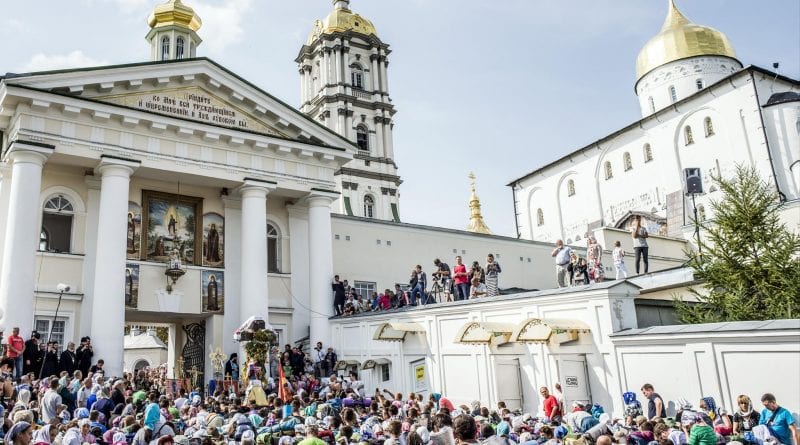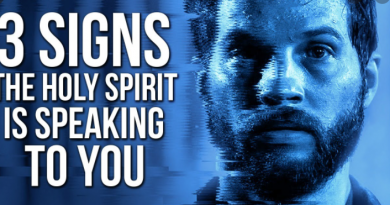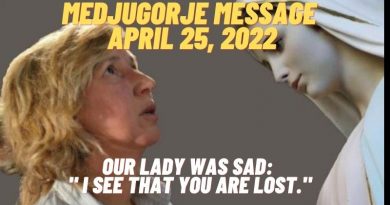SIGNS OF FATIMA’S HIDDEN THIRD SECRET? RUSSIA CAPTURES UKRAINIAN SHIPS. BUT IS THIS CHURCH THE NEXT BATTLEGROUND?
Reader of Fatima’s “Third Secret”, Malachi Martin before his death had some extraordinary things to say about Fatima, the Third Secret, Ukraine and Russia. Fr. Martin wrote: “Sister Lucia’s single-page letter of the “Third Secret” covers three topics—
1. A Physical chastisement of nations
2. A spiritual chastisement
3. The central function of Russia in the two which in fact, the physical and spiritual chastisements are to be girded on a fateful timetable in which Russia is the ratchet. Russia´s role in the Vision of Fatima is very important because if we´re to believe the Vision of Fatima, salvation for the world, the cure for the world ills, will start in Ukraine and in Russia”
SOURCE OXY.COM – Check out their great news site
RUSSIA CAPTURES UKRAINIAN SHIPS. BUT IS THIS CHURCH THE NEXT BATTLEGROUND?
Russia fired upon and seized three Ukrainian ships over the weekend for allegedly violating its territorial waters while crossing the Kerch Strait, which Russia has effectively controlled since it seized Crimea from Ukraine in 2014. The worrying escalation saw the two militaries come into open conflict, and Kiev is now mulling martial law in response. Inland, meanwhile, religious tension is bubbling.
Taras Palianytsia isn’t religious, but the Holy Dormition Pochayiv Lavra monastery has been on his mind a lot lately. Built on a hill in the 16th century, the monastery towers over the small western Ukraine city of Pochayiv that Palianytsia calls home. The shrine is Ukraine’s second biggest monastery and one of its most sacred Orthodox sites. But right now, Palianytsia, a deputy in the local city council and member of the nationalist “Svoboda” (Freedom) party, says the monastery is “a problem.”
A country of 42 million people with two-thirds of its population being Orthodox, Ukraine is in the midst of a tussle over its religious identity. In early October, the Istanbul-based Constantinople Patriarch, considered “first among equals” in the Orthodox world, announced its intention to grant Ukrainian clerics independence from the Russian Orthodox Church, which controls the Pochayiv monastery and has, until now, dominated religious life in Ukraine. The previously unrecognized Church of the Kiev Patriarchate will take a leading role in the new church.
There’s just one problem: The Moscow Patriarchate currently controls nearly 12,000 parishes in the country, which face an uncertain future once Ukraine gets its own, independent Orthodox church. And as one of Ukraine’s most important religious centers, the Pochayiv monastery finds itself at the heart of this dispute, a key prize for both sides, and a bellwether for the battle over the other smaller parishes.
TENSIONS ARE HIGH.
VLADIMIR FESENKO, KIEV-BASED POLITICAL ANALYST
Members of the far-right “Right Sector” group disrupted a meeting of the city council last year and prevented deputies from voting on a proposal to allocate more land to the monastery. Palianytsia was a part of those protests. And last week, after Palianytsia alleged that a 2003 agreement illegally gave the Moscow Patriarchate control over the monastery until 2052, Ukraine’s Justice Ministry canceled its registration of the Pochayiv shrine buildings to the Moscow Patriarchate.
Representatives of the Kiev Patriarchate have repeatedly declared that no one would be forced to join the new church. But the head of the Kiev Patriarchate, Patriarch Filaret, told a Ukrainian television channel in August that Pochayiv Lavra and the Kiev Pechersk monastery — where the Moscow Patriarchate in Ukraine is currently based — would be “handed over to the Ukrainian church” once its independence is confirmed, though he didn’t say how that would happen.
(In the above video, far-right groups can be seen disrupting a city council meeting where a proposal to allocate more land to the monastery was being discussed.)
Supporters of an independent Ukrainian church in Pochayiv, meanwhile, allege that followers of the Russian church pose the biggest risk, as they could stage provocations. In late August, pictures appeared on social media showing dozens of men near the monastery wearing identical black shirts sporting orthodox crosses and a biblical quote saying “prepare for war.”
“Tensions are high,” says Vladimir Fesenko, a political analyst based in Kiev. “There is a risk that nationalist groups could intervene, yes. But the Moscow Patriarchate is also able to mobilize its own people, and that’s very dangerous.”
Asked whether the threat of an attack is real, a guard in green fatigues points to a paper declaration signed by the head of the monastery and stuck on a wooden panel. “Lenin’s spiritual grandchildren are threatening violence,” it cautions, almost apocalyptically. “Anyone who cares about the fate of the monastery must stand ready to defend it!”
“Of course there’s a threat,” says Pavel, the guard, declining to share his full name because he isn’t authorized to speak with journalists.
At first glance, the atmosphere inside the religious complex — with three cathedrals and several churches — is quiet. But the tension that Fesenko speaks of is visible easily enough. A sign near the entrance exhorts followers not to “listen to schismatics and heretics.” Next to it, a two-meter-high drawing of a tree portrays Orthodoxy with a mighty trunk and flourishing leaves, while dead branches are marked as “Catholicism,” “Mormons” or “Kiev Patriarchate.”

The monastery might be opposed to the independence of the Ukrainian church, but believers coming here from all over Ukraine are more divided, with many supporting the Kiev Patriarchate or refusing to take sides. “Everyone has a different opinion here,” says 28-year-old Kolya Ketsman from the nearby city of Ivano-Frankivsk. “But this is a holy place, brothers and sisters need to sit down and talk.”
In many ways, the Maidan Revolution of 2014 was a watershed moment for the Ukrainian Orthodox Church of the Moscow Patriarchate. While priests of the Kiev Patriarchate supported protesters against Moscow-backed President Viktor Yanukovich, who was eventually ousted, members of the Russian-affiliated church either stayed neutral or voiced their opposition to the new authorities. As the war in Eastern Ukraine rose in intensity, so did the accusations about the Moscow Patriarchate being closely linked to the Russian state. For many in Ukraine, the creation of a Ukrainian church is as much about severing ties with Russia as it is about religion.

That divide has played out in Pochayiv too, 600 miles from the frontline. The monastery is in an unusual position: located in Western Ukraine, a region widely considered to be the heart of Ukrainian nationalism. The shrine is sometimes described as a “stronghold” of the Moscow Patriarchate in a part of the country dominated by the Kiev Patriarchate. “Monks are very conservative,” says Nicholas Denysenko, a professor of theology at Valparaiso University and an ordained deacon of the Orthodox Church in America. “Many of the bishops or monks who are part of these monasteries were specifically trained to view the Kiev Patriarchate as separate and as permanently illegitimate.”
That attitude makes the monastery particularly vulnerable. “Before 2014, the monastery had a lot of influence here,” Palianytsia says. “But the revolution changed a lot of things.” The implications of the Justice Ministry decision to cancel the monastery’s registration to the Moscow Patriarchate are unclear, but the move speaks to the “pressure” the shrine is under, a Moscow Patriarchate representative has said.
Already, about 120 churches across Ukraine have shifted allegiance to the Kiev Patriarchate since 2014, and that was before the announcement that the country would get its own Orthodox church. In some cases, nationalist groups had pressured those churches to switch loyalties. Officially, Ukrainian authorities deny any plans to force religious sites to join the new church. Any violence, President Petro Poroshenko has declared, could only be the work of “Moscow agents.” But the Moscow Patriarchate says radical groups could attempt to capture its properties.
“We know the state won’t protect us, because these attacks have happened before, and the state has done nothing to investigate them,” says Archbishop Kliment, the spokesman of the Moscow Patriarchate in Ukraine.
Nowhere is that concern more pronounced than at the Pochayiv monastery, which embodies the considerable stakes for an independent Ukrainian Orthodox church. Every year, thousands of believers pass through the religious complex that is closely associated with early Slavic Orthodoxy. In the new religious conflict that’s brewing in Ukraine, “everyone is going to watch to see what happens [to the Pochayiv shrine],” Denysenko says.






